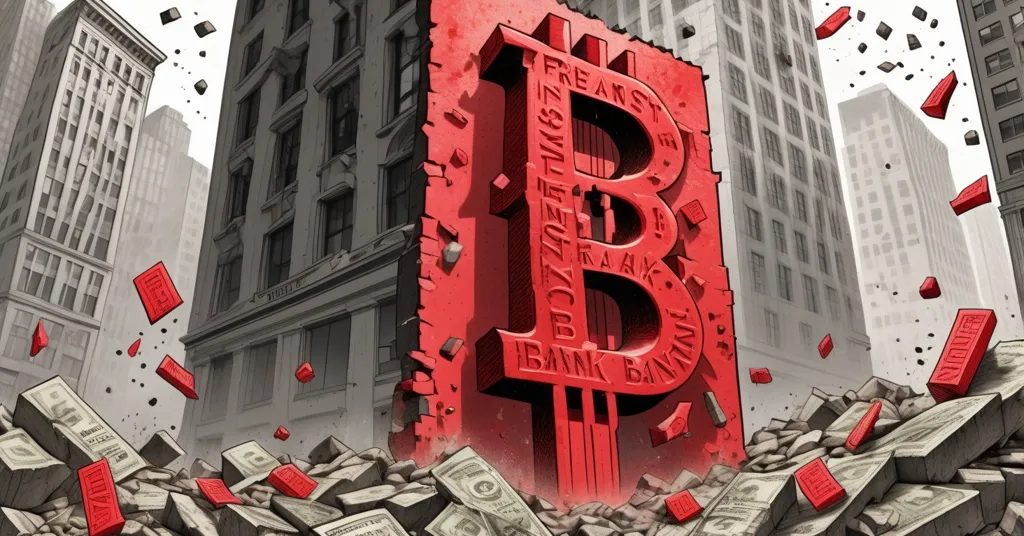Jefferies Stock Crashes 25% on Fraud Claims: Crypto Lessons from First Brands Debacle

Jefferies Shares Plummet 25% as CEO Alleges Fraud in First Brands Fiasco: What Crypto Can Learn
Jefferies, a heavyweight in investment banking, is taking a brutal hit with its stock nosediving 25% in just a month, all thanks to a catastrophic tie-up with the bankrupt auto parts supplier First Brands Group. CEO Rich Handler dropped a bombshell at a recent investor day, accusing First Brands of outright fraud, while the fallout raises damning questions about risk management—not just at Jefferies, but across the U.S. banking sector. For those of us in the crypto space, this reeks of familiar scams and blind trust, offering a stark reminder of why decentralization matters.
- Stock Crash: Jefferies’ shares tank 25% over First Brands exposure.
- Fraud Claim: CEO Rich Handler accuses First Brands of deception.
- Industry Ripples: Wider credit concerns drag down KBW Regional Bank Index by 6%.
Jefferies’ $715 Million Blunder: How It Unraveled
The scale of Jefferies’ mess is jaw-dropping. Through its investment arm, Point Bonita Capital, the bank had nearly three-quarters of a billion dollars—$715 million, to be exact—tied to First Brands. On top of that, Jefferies’ leveraged finance unit was instrumental in helping First Brands secure billions in debt, including a staggering $6 billion loan deal that got scrapped in August after glaring warning signs emerged. For the uninitiated, leveraged finance means lending huge sums to companies already drowning in debt, often for aggressive moves like acquisitions. It’s a high-stakes gamble—massive profits if it works, total disaster if it doesn’t. Guess which way this went.
First Brands, an auto parts supplier, reportedly buckled under post-COVID supply chain chaos and crippling debt loads, failing to hit revenue targets that justified such massive loans. Missed payments and shady financial reports were the red flags that ultimately killed the $6 billion deal. But by then, Jefferies was already neck-deep in exposure. At the investor day, Handler didn’t mince words, declaring,
“We believe we were defrauded, OK?”
He even made it personal, adding,
“I’ll just say, this is us personally, we believe we were defrauded.”
Details on what exactly went wrong are scarce for now, likely to be dragged out in bankruptcy court—a legal arena where a failed company’s debts and assets get dissected under strict oversight, often exposing hidden truths through evidence and testimonies. For more on this unfolding drama, check out the latest on Jefferies’ stock tumble and fraud allegations.
President Brian Friedman tried to soften the blow, insisting the exposure was linked to First Brands’ “investment-grade-rated customers”—meaning clients or companies credit agencies deemed low-risk, expected to repay debts reliably. He also noted Jefferies held only a small equity stake in the fund and hinted at a legal fight ahead, saying,
“If this was fraud—and we don’t know—there’s going to be a knockdown process in bankruptcy court and we’re going to see what’s learned.”
But investors aren’t swallowing the spin. One unnamed investor slammed it as a
“Risk management 101 failure,”
and frankly, the reek of sheer incompetence or outright negligence is hard to ignore, especially with Jefferies’ recent hedge fund losses tied to an alleged Ponzi scheme. Bad luck? More like a pattern.
Banking Sector Tremors: A Systemic Crisis Brewing?
This isn’t just Jefferies’ headache—it’s a warning shot for the entire U.S. banking sector. On the same day Handler aired his grievances, the KBW Regional Bank Index, a key measure of regional bank health, cratered 6%. Other players like Western Alliance and Zions Bank have raised alarms over allegedly fraudulent borrowers, with Western Alliance reporting a 10% spike in non-performing loans this quarter and Zions flagging $200 million in questionable borrower assets. Meanwhile, auto lender Tricolor is catching heat for its own loan troubles. Handler summed up the chaos, pointing to an industry-wide blame game:
“There’s a fight going on right now between the banks and direct lenders… each wants to point fingers… it’s your fault, no, it’s your fault.”
It’s less a professional dispute and more a sandbox spat, while investors are left holding the bag.
Let’s zoom out for context. Rising interest rates and post-COVID economic strain have squeezed borrowers and lenders alike, exposing deep-rooted flaws in how the banking system handles risk. Mid-tier banks like Jefferies, hooked on leveraged finance for big returns, are especially vulnerable when deals implode. Analyst Ian Lapey from Gabelli cut to the chase, arguing it’s tough to paint this as a one-off given Jefferies’ string of missteps. Worries about borrowers failing to repay loans—a.k.a. credit quality fears—are bubbling up everywhere, echoing the kind of sloppy due diligence that triggered cascading failures during the 2008 financial crisis. History doesn’t repeat, but it sure as hell rhymes.
To be fair, not every high-risk bet can be predicted to flop. Leveraged finance is inherently a roll of the dice, and Jefferies could argue they relied on data that looked solid at the time. But facilitating billions in debt for a company that ends up bankrupt isn’t a minor oops—it’s a neon sign screaming systemic rot. If fraud is proven in court, they might recover some losses, but the damage to credibility? That’s a steeper hill to climb.
Crypto’s Parallel: Trust Without Verification Spells Doom
For those of us tracking Bitcoin and blockchain, this fiasco hits close to home. Fraud allegations, massive financial exposures, and shattered investor trust aren’t exclusive to traditional finance (TradFi). We’ve seen our share of rug pulls, Ponzi-like schemes, and exchange meltdowns in the crypto space. Just as Jefferies got burned by trusting First Brands’ numbers without digging deeper, countless crypto investors dumped millions into Terra’s UST stablecoin, assuming its peg was ironclad—until it shattered in 2022, wiping out billions. Both cases scream the same brutal truth: trust without verification is a fast track to ruin.
The parallels don’t stop there. Leveraged finance in TradFi mirrors some crypto lending protocols—think platforms like Celsius, which promised sky-high yields on staked assets, only to collapse under over-leveraged bets and opaque operations. In both worlds, the allure of quick gains often blinds players to the risks. Bitcoin maximalists might smirk and say this is why trustless systems are the future—Bitcoin’s design cuts out the middleman, with transactions verified on an immutable ledger. No need to trust a bank or a shady CEO when the blockchain doesn’t lie. But let’s not get cocky. Even in crypto, human greed and centralized chokepoints—like exchanges or poorly audited DeFi projects—can replicate TradFi’s failures. Due diligence isn’t just a TradFi problem; it’s a universal one.
Blockchain’s Promise: Disrupting TradFi’s Broken Foundation
This is where decentralization shines, and why I’m all in on effective accelerationism—pushing hard and fast for tech that bulldozes flawed systems. Blockchain transparency could theoretically prevent fraud like the First Brands debacle. Imagine if Jefferies had access to an immutable record of First Brands’ finances, updated in real-time on a public ledger. No fudged numbers, no hidden debts—just raw, verifiable data. Bitcoin offers that trustless backbone, while altcoins like Ethereum bring smart contracts into the mix, automating agreements without shady intermediaries. These aren’t just patches for TradFi’s holes; they’re a complete teardown of a broken foundation.
That said, crypto isn’t a silver bullet. Centralized exchanges still fall to hacks or mismanagement—FTX, anyone?—and unregulated DeFi can be a Wild West of scams. The tech is only as good as the people using it, and greed doesn’t discriminate between Wall Street and Web3. Still, Jefferies’ faceplant is a textbook case for why we need to accelerate decentralized finance (DeFi) solutions. If we can build systems where trust isn’t a gamble but a mathematical certainty, we’re not just disrupting the status quo—we’re burying it.
Key Questions and Takeaways
- Why did Jefferies’ stock crash 25%?
A $715 million exposure to the bankrupt First Brands Group through Point Bonita Capital, plus billions in facilitated debt, rattled investors over glaring risk management failures. - What’s behind the fraud claim against First Brands?
CEO Rich Handler insists Jefferies was misled in its dealings, though specifics remain unclear and are set to unfold in bankruptcy court proceedings. - How does this reflect wider banking sector issues?
A 6% drop in the KBW Regional Bank Index, alongside fraud and loan troubles at other banks like Western Alliance and Tricolor, signals systemic concerns about borrowers failing to repay amid economic pressures. - What lessons can crypto draw from this TradFi mess?
Fraud and unchecked risk plague both sectors; blockchain transparency and trustless systems like Bitcoin offer a potential fix, but only if paired with rigorous due diligence. - Can Jefferies bounce back from this disaster?
Recovery depends on legal outcomes in bankruptcy court and rebuilding investor trust, but further missteps or market downturns could worsen the damage to both finances and reputation.
Jefferies’ implosion isn’t just a headline—it’s a blaring alarm for anyone in high-stakes finance, crypto included. As we champion decentralization and privacy, let’s not ignore the old guard’s spectacular failures; they’re our best teachers. If Bitcoin is the ultimate trustless system, why do so many in our space still fall for centralized traps? Chew on that while Jefferies scrambles to salvage its wreckage. Stay sharp, question everything, and never stake your future on blind faith. That’s a lesson worth more than any $6 billion loan flop.



